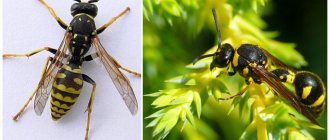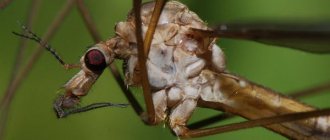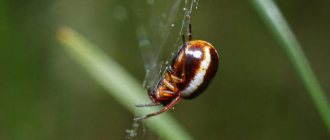Description and features of the tarantula
The main feature is a large number of eyes, 8 of them, due to which the spiders have a viewing angle of 360 degrees.
They also have an excellent sense of smell, thanks to which arthropods can easily sense prey at a great distance. Its body is covered with small hairs, and in the structure itself two main parts can be distinguished - the head, which grows into the chest and protrudes as one whole, and the abdomen. During its life, the tarantula spider changes the chitin found on the surface of its body. The arachnid has 4 pairs of long legs, which are covered with hair, which allows them to move freely through water or sand.
There are poisonous channels on the mandibles - they are used as a means of defense and attack and are very strong.
They are painted either black or brown, although you can meet animals of light shades - it all depends on where the animal lives.
Virulence
As a rule, they do not attack a person on their own, only if he forces him to do so on his own - for example, by hitting a mink or arthropod. An animal bite is not fatal to a healthy person; it is dangerous if there is an allergic reaction to the components of the poisonous substance.
The following unpleasant symptoms may occur:
- swelling, redness of the epidermis;
- malaise, drowsiness;
- hyperthermia;
- breathing problems;
- feeling nauseous or vomiting.
There are no non-venomous tarantulas. But the bite will be fatal only for the animal that the tarantula decided to hunt.
If a person is bitten by a tarantula, he still needs to receive help to avoid poisoning and subsequent intoxication. The following actions are performed:
- wash the bite site, preferably with an antiseptic;
- seek qualified medical help;
- Place a container of ice on the wound to cool the skin;
- if there are allergic reactions, take antihistamines;
- drink a lot of clean water - it removes toxins that poison the body.
External structure
Let's take a closer look at what tarantulas look like. It has 8 eyes on the top of its head - this is the case for almost every animal from this family, 4 of them are trapezoidal. It is difficult to say exactly what size a tarantula is, there are large specimens - up to 10 cm, and there are also very small ones, so it would be incorrect to say that all arthropods are large. Females are always larger than males - sometimes several times.
Chelicerae are stinging and at the same time oral appendages. Males are smaller than females and their limbs are not as developed. As for how many legs a tarantula has, the answer is the same: 4 pairs, that is, 8 in total, like the eyes.
Tarantulas are solitary and meet with other individuals when they need to reproduce, as a rule, this happens in the second half of August. Males always fight with each other.
Internal structure
Let's look at the structure of the tarantula. The following important systems can be distinguished:
- digestive. The liver is used as a gland that digests food; spiders have 2 stomachs, and there is also an intestine.
- Blood It looks like a tube from which a large number of vessels extend; a colorless liquid flows through them, which experts call hemolymph.
- Respiratory. The exoskeleton of an arthropod has openings called spiracles. Through them, air penetrates into the lungs, which also have an interesting structure. Each wall is folded like the pages of a book, which is why the lungs are usually called pulmonary books.
Even though arachnids do not spin webs, they still have arachnoid glands. Females weave cocoons for eggs from silk, which also serves to insulate and strengthen the mink.
Features of character and lifestyle
Photo: Tarantula spider
Tarantulas, unlike their counterparts, do not spin webs. They are active hunters and prefer to catch prey on their own. They use webs as traps to find out about a beetle or other insect running past. Weaves can warn of approaching danger.
The arthropods sit in the hole all day, and in the evening they emerge from the shelter to hunt. With the onset of cold weather, they seal the entrance to their cave and hibernate. Among the individuals there are real long-livers. Some subspecies can exist up to 30 years. The main part of the species lives on average 3-10 years. Females have a longer lifespan.
The growth of the spider does not stop at any stage of development. Therefore, their exoskeleton changes several times as they grow older. This allows the animal to regrow lost limbs. With the next moult, the leg will grow back, but will be much smaller than the rest of the limbs. After the next molt, it will reach normal size.
Interesting fact: Spiders mostly move on the ground, but sometimes they climb trees or other objects. Tarantulas have claws on their paws, which they, like cats, extend to have better grip on the surface on which they climb.
Where does the tarantula spider live?
The habitats of the species are represented by a wide range - the southern part of Eurasia, North Africa, Australia, Central and Asia Minor, America. Representatives of the genus can be found in Russia, Portugal, Italy, Ukraine, Spain, Austria, Mongolia, Romania, and Greece. Arthropods choose arid areas to live.
They live mainly in:
- deserts;
- steppes;
- semi-deserts;
- forest-steppes;
- gardens;
- vegetable gardens;
- on the fields;
- meadows;
- along the banks of rivers.
Tarantulas are heat-loving arachnids, so they cannot be found in cold northern latitudes. Individuals are not particularly picky about their habitats, so they even live in saline steppes. Some manage to get into houses. Distributed in Turkmenistan, the Caucasus, Southwestern Siberia, and Crimea.
Most predatory spiders prefer to live in burrows that they dig themselves. They choose the location for their future home very carefully. The depth of vertical burrows can reach 60 centimeters. They move the pebbles to the side and rake out the soil with their paws. The walls of the tarantula's shelter are covered with cobwebs. It vibrates and allows you to assess the situation outside.
At the end of autumn, spiders prepare for wintering and deepen their homes to a depth of 1 meter. The entrance to the hole is plugged with leaves and branches. In the spring, animals crawl out of the house and drag the web behind them. If it suddenly breaks, there is a high probability that the animal will no longer find its shelter and will have to dig a new hole.
Apulian tarantula - Lycosa tarantula
Apulian tarantula photo
This tarantula reaches 7 cm in length. The body is gray-brown, covered with white hairs. There are many light and dark, longitudinal and transverse stripes on the body. They live in Southern Europe: Portugal, Spain, Italy. The Apulian tarantula lives in burrows up to 60 cm deep. It emerges from the burrow in the evening and hunts insects. In winter, the Apulian tarantula closes the entrance to its burrow with dry leaves fastened with cobwebs. Females of this species live up to 4 years, and males up to 2 years and mate once. Females lay eggs in a web cocoon and wear it on themselves. After some time, the spiderlings emerge from the cocoon and remain on the mother’s abdomen for a short time. Tarantula venom is not very toxic, but causes painful swelling in humans at the site of the bite. Photo of a Puglian tarantula
Population and species status
The greatest distribution of these arthropods is associated with forest-steppe, steppe and desert zones. Their total numbers have been steadily decreasing until the last ten years, when the process of population decline has slowed down significantly. Experts believe that this was facilitated by the general warming of the climate on our planet.
Commercial activities cause significant harm to tarantula populations. These arachnids are caught in third world countries and sold for little money in order to somehow survive in difficult conditions. Therefore, in countries where the economy is very weak, the number of tarantulas is constantly decreasing.
Human activity is causing serious damage to spider populations in countries such as Bolivia and Brazil. Due to population growth, tropical forests are being cut down at a tremendous rate. In addition, artisanal methods of extracting gold and diamonds are used, which leads to the destruction of the surface layer of the soil. Large volumes of water are pumped underground, which disrupts the integrity of the landscape. As a rule, such territories become unsuitable for life for many living beings.
Description of the tarantula
The tarantula is part of the wolf spider family, although they are constantly trying to mate it with tarantula spiders (lat. theraphosidae). Tarantulas differ from the latter in the direction of movement of the jaws.
Chelicerae (due to poisonous ducts on their jagged tops) perform two functions - an oral appendage and an attack/defense weapon.
The most attractive thing about the tarantula’s appearance is its 3 rows of shiny eyes: the first (bottom) row consists of four tiny “beads”, 2 larger eyes are “mounted” on top of them, and, finally, another pair is placed on the sides.
Eight spider “eyepieces” vigilantly monitor what is happening, distinguishing light and shadow, as well as the silhouettes of familiar insects at an interval of up to 30 cm. The spider boasts excellent hearing - it can hear human steps 15 km away.
The tarantula grows, depending on the variety, up to 2.5 – 10 cm (with a limb span of 30 centimeters).
Females are larger than their partners, often gaining a record weight of 90 grams.
The color of the spider can vary and depends on its habitat. Thus, the South Russian tarantula usually displays a brown, slightly reddish or sandy-gray color with black spots.
What does the tarantula spider eat?
Tarantulas are real predators. They wait for their victims from an ambush, and then quickly pounce on them.
The diet of arthropods includes many insects and amphibians:
- Zhukov;
- caterpillars;
- cockroaches;
- mole cricket;
- crickets;
- ground beetles;
- small frogs.
Having caught prey, the arachnids inject their poison into it, thereby paralyzing it. When the poison begins to act, the victim's internal organs turn into a liquid substance, which after some time the tarantulas suck out like a cocktail.
Typically, predators select prey according to their size and spread out their food intake over several days. Individuals can go without food for a long time, but having a constant source of water is a must. There is a known case where a female tarantula was able to go without food for two years.
Near the burrow, arachnids pull signal threads. As soon as they feel that someone is crawling past their home, they immediately crawl out and grab the prey. If the prey turns out to be large, the predator jumps back and jumps on it again to bite it again.
If the prey tries to retreat, the spider chases it for up to half an hour, occasionally inflicting new bites. All this time he tries to stay at a safe distance from the victim. Usually at the end of the battle the animal gets its way and gets a well-deserved lunch.
The meaning of the tarantula in nature and human life
Although a tarantula bite can be dangerous to humans, these animals are actually beneficial to the environment where they eat pests.
It is noteworthy that sometimes tarantula venom is even used in the medical field, which is why they began to be bred in captivity. People have been trying for a long time to find out what the web is made of - in order to make fabric from it in the future.
There is a known case where one magician managed to create stockings and gloves from a spider’s web - but in one copy.
Tarantula lifestyle
Burrows of a large tarantula can be seen everywhere, most often the slopes of mountains are covered with them. The depth of the burrows varies, ranging from 50-60 cm deep. At the entrance to the tarantula's burrow you can see a small roller, which somewhat hides the entrance from prying eyes.
During the daytime, spiders prefer to hide in burrows. And when night falls, they go out hunting. Spiders protect their burrows from the winter cold using cobwebs and dry plants. All the walls in their home are shrouded in cobwebs. With its help, they are able to determine by vibration what is happening on the earth's surface.
As soon as the spring warmth is felt, spiders come to the surface and bask in the sun's rays.
Tarantula nutrition
They actively hunt at night. Large spiders catch mice, frogs, birds; small ones - insects. And they do it very carefully. Slowly crawls towards the victim, then quickly jumps and bites. It pursues large prey for a long time.
The spider catches insects not far from its hole, but does not go far, since it is attached to it by its own web. First, it bites through the victim, injects poison into it, dissolving the internal organs, then it simply sucks everything out.
It's already eating inside. It also happens that a careless beetle, cricket or grasshopper gets into a hole. If the web suddenly breaks, the spider cannot find its way home, and a new one will have to be made.
Natural enemies of tarantula spiders
The tarantula has quite a few enemies. The main culprits in the death of arthropods are birds, since they are part of the diet of birds. Wasps encroach on the life of arachnids, just as spiders do with their victims. They inject poison into the tarantula's body, paralyzing the predator.
They then lay eggs inside the spider. Parasites live and develop, after which they get out. Natural enemies include some types of ants and mantises, which are not at all picky about food and eat everything that moves. Frogs and lizards are not averse to eating tarantulas.
The most dangerous enemy is still the same spider. Arthropods tend to eat each other. A female, during the process of fertilization, can encroach on the life of a male individual, like a female praying mantis, or eat her offspring if she cannot trap some insect.
There is continuous hostility between tarantulas and mole crickets. Their habitats overlap. Mole crickets dig the soil, where spiders often climb. Sometimes individuals manage to escape. Wounded or molting arthropods usually become food for the enemy.
In general, the population suffers most in early spring. When lethargic and sleepy arachnids crawl out of their shelters, the mole cricket is right there. Sometimes they climb into spider holes and attack tarantulas with their forelimbs, delivering heavy blows. When the spider loses a lot of blood, the mole cricket eats it.
Dzungarian tarantula
The South Russian or Dzungarian tarantula is common in the Caucasus, Central Asia, and southern Ukraine. Here it can be found in the steppes, in floodplain meadows near rivers.
When viewed from the front, the Dzungarian tarantula is quite cute and resembles a fairy-tale gnome. In a calm state, its front legs are lowered and a large streamlined head part of the body is visible, below is a transverse strip of short hairs, reminiscent of a short whisker brush; under it there is thick, longer hair, similar to a goatee, and above there are 2 large and under them 4 smaller eyes
Just a cartoon character! But if suddenly someone had the imprudence to disturb it, the picture changes radically: the spider raises its front legs high above its head, taking a threatening pose. Now he no longer looks like the sweetest creature
He's ready to attack!
The tarantula's vision is excellent. The spider has 8 eyes located at the cephalothorax end. 4 of them are shiny and clearly visible, and 4 are duller. The spider's 8 large legs, widely spaced in all directions, are covered with long black hairs. The poisonous apparatus of the tarantula is located on the sides of the anterior section of the cephalothorax and consists of two glands, the ducts of which end at the sharp ends of the strong jaws.
Reproduction and lifespan
Towards the end of summer, tarantulas become sexually mature. At these moments, males go out in search of females in the hope of mating. But these searches do not always end with the fulfillment of their desire. Sometimes the male may simply be eaten by the female. Therefore, in order to stay alive, they must not lose their vigilance for a single second.
When they meet, the males begin some kind of flirting. They actively vibrate their abdomen and move their forelimbs, giving a chance to understand their aspirations.
A female who is not against mating begins involuntary repetitions of all the movements of the male. After mating has taken place, it is advisable for the male to quickly retreat, otherwise he risks being eaten by a hungry spider.
The fertilized female has no choice but to hibernate in a well-walled hole. And only the arrival of spring makes it come to the surface.
In the abdomen exposed to the rays of the sun, offspring are formed in the form of eggs in the female. She lays already ripe eggs on the web she has prepared. The number of eggs depends on the species of tarantula. Their average number is about 400 pieces.
South Russian tarantula
The eggs are in the ripening stage. At the same time, the female builds a large cocoon, places her eggs there and attaches them to herself. The cocoon is on the spider until the first movements of the babies in it.
The female remains to gnaw the cocoon and help the offspring get out of it. Newborn spiders are in no hurry to leave their mother. They climb onto it and are placed there in several layers.
They live this way until the babies are able to eat on their own. After which the females have another mission - she needs to go around as much of the territory as possible and scatter her offspring over it. Tarantulas can live up to 20 years.
What to do if you are bitten?
After a tarantula bite, you must immediately provide first aid to the injured person. It is very important to slow down the spread of poison throughout the body and speed up its elimination. If a child or a person prone to developing allergies has suffered from an arachnid attack, you should immediately consult a doctor.
Signs of a bite
Usually a person feels that he has been bitten by a tarantula. The sensations are approximately the same as when a hornet stings - a painful, burning sting. The local reaction manifests itself as follows:
- two noticeable punctures from the chelicerae;
- redness and swelling of the affected skin area;
- painful burning at the site of the bite, less often itching;
- the temperature of the skin next to the wound rises.
Some victims after a bite experience dizziness, weakness, and their pulse quickens.
The body of allergy sufferers reacts much more severely to tarantula venom. They may experience:
- a sharp increase in temperature;
- headache;
- muscle pain;
- severe swelling;
- low pressure;
- nausea;
- numbness of the limbs;
- labored breathing.
In severe cases, anaphylactic shock develops and the victim may die, so medical attention should be provided immediately.
First aid for a bite
Providing first aid to a victim bitten by a tarantula is as follows:
- thoroughly rinse the bite site with clean water;
- treat the wound with an antiseptic;
- Apply a cold compress to the affected area.
If the pain is severe, you can take a pain reliever, and to prevent the development of an allergic reaction, an antihistamine.
Bite
After a tarantula bite, it is very important for a person to remain calm and drink plenty of warm liquids. This will speed up the elimination of toxins and alleviate the general condition.
What not to do?
To avoid serious consequences after a tarantula bite, you should not:
- warm the bite site;
- try to squeeze out the poison (this will only speed up its spread);
- scratch or cut the skin in the affected area.
As for the advice to smear the wound with the blood of an attacking spider, it is very doubtful. Indeed, the blood of a tarantula is an antidote to its poison, but by applying the blood of a killed arthropod to an open wound, you can introduce an infection into the body, which will lead to the development of serious complications.
Types of tarantulas
The genus Tarantula includes more than 200 species of spiders. Among them, the most famous are the following types.
Apulian tarantula
He is a real tarantula, lives in the south of Europe, including Italy (most likely it was he who gave the name to the entire species of these spiders) and also in North Africa. It is approximately 7 cm in length. Also, unlike other species of tarantula, it does not spin webs.
South Russian tarantula or Mizgir
As the name suggests, this tarantula lives in the south of Russia, Belarus, as well as our country Ukraine, in the countries of Central Asia. This species of tarantula is small, rarely exceeding 35 mm in size. A characteristic feature of this type of tarantula is the presence of a special dark cap. With the onset of cold weather, these tarantulas burrow deep into their burrows, where they successfully winter, and with the onset of spring they come to the surface.
Tarantula Lycosa narbonensis
Reaches a size of 5-6 cm. The body of the poisonous spider is brown-black, the legs are long, covered with hairs. Tarantulas are found in Italy, France, Macedonia, Malta, Spain, the countries of the former Yugoslavia and northern Africa.
Spanish tarantula
This tarantula also lives in southern Europe, particularly Spain, Italy, Portugal, and North Africa. It was once considered a subspecies of the Apulian tarantula, but was later classified as a separate species.
Brazilian tarantula
This type of dark brown tarantula lives in the tropical forests of South America, Brazil, Paraguay, and is found in many other South American countries. A characteristic feature of this tarantula is the presence on its head of a light longitudinal stripe of a yellowish tint.
Tarantula Lycosa poliostoma
Lives in South American countries: Brazil, Uruguay, Argentina, Paraguay. It lives in gardens, steppes, meadows, during the day it hides among the grass or in trees, in stones or holes, and is nocturnal. Like other species, these tarantulas eat crickets, cockroaches, small insects and other spiders. The length of the spider, excluding the legs, is 3 cm. The color of the tarantula is gray-brown or dark brown. There is a light longitudinal stripe on the head. In the upper part of the abdomen, the strip takes the shape of an arrow that points forward. The lower part of the tarantula's abdomen is black. The color of the chelicerae is light, which distinguishes this type of spider from the Brazilian tarantula. Females are larger than males, but females have shorter legs.
Tarantula Lycosa leuckarti
This is a gray-brown spider. The length of males reaches 0.9 cm, females - 1.2 cm (excluding paws). This species of tarantula lives in Australia.
Blue Tarantula - Haplopelma lividum
The blue tarantula reaches 15 cm in length, ranging from light blue to dark blue, with a purple tint. It is found in Thailand, Laos, Cambodia, and Vietnam. Despite its bright color, the blue tarantula lives in an earthen hole. It feeds on large insects, hunts them in the evening or catches them running past holes. The blue tarantula reaches sexual maturity in one year, and females in the second year of life. It is not difficult to keep this spider at home. Required temperature 22-24° C, ambient humidity 80-85%. It is necessary to pour 6-8 cm of substrate into a terrarium or aquarium. The blue tarantula is poisonous, but its poison is not fatal. A person bitten by it experiences burning pain at the site of the bite, and the area becomes swollen and inflamed. But after some time these symptoms disappear. It is recommended to pick it up only for people experienced in this matter, since the blue tarantula is quite aggressive and fast.
Black Tarantula - Grammostola pulchra
The description is as follows: this tarantula tarantula is 6-7 cm in size, black in color and densely covered with hairs. Lives in Brazil. Prefers a fairly humid environment (about 60-70 mm per month) and a temperature of 18-25 C°. When the cold season comes, the black tarantula digs a hole in the ground, where it spends the winter. As a pet tarantula, this is an excellent option, as it is quite calm and not fast. Moreover, this is a long-lived spider, it lives up to 20 years. Due to their slow development, black tarantulas become adults at 6-7 years of age. They feed on insects. This spider is kept in terrariums filled with substrate with different shelters and recesses. Their mating is peaceful and calm. After mating, the female lays eggs in a web cocoon, where there are about 100 spider embryos. The spider guards the cocoon and carries it with her. The black tarantula is not dangerous, it is quite calm, but if handled incorrectly, it can bite. The symptoms of its bite are similar to those of a bee or hornet sting.
King Baboon Tarantula
This is the largest tarantula spider, its body length reaches 23 cm. The king baboon tarantula is light red to dark brown in color. The body is covered with short hairs. It has very strong and large legs, especially its hind leg (8 - that’s how many legs tarantulas have). Thanks to this, he takes a stance, warning his enemy of the attack. At the same time, he rubs his paws and makes a characteristic sound. Lives in eastern Africa, Kenya, Tanzania. The king baboon feeds on large insects, lizards, and small birds. Many lovers of exotic spiders want to have such a handsome spider in their home, but the question arises: is it dangerous? The king baboon is quite aggressive and fast, his character is unpredictable. If something goes wrong, he can easily bite you. So beginners in this business should be careful. Its venom is not fatal to humans, but causes pain, burning and swelling at the site of the bite. It also has large and sharp chelicerae (jaws) with which it pierces the skin. As you can see, a tarantula bite is not fatal to humans, but quite painful. Therefore, with peaceful and correct coexistence with him in your home, you will only receive pleasure from contemplating these beautiful creatures. Caring for them does not require much effort. The main thing is to adhere to the temperature and humidity in which this or that species is used to being.
You already understand what to feed the tarantula. The above species have the same tastes - these are live insects. But how much a tarantula costs depends on the species: the more exotic the tarantula, the higher its price. Don't be afraid to have tarantulas in your home, it's an amazing experience. But at the same time, do not forget about the characteristics of your pet and be careful.
White tarantula
Here is a short description of the white tarantula. Its body is the size of a coin (2-3 cm). The cephalothorax is white, the abdomen and other parts of the body are dark brown. The white tarantula does not yet have a binomial name, as it was discovered quite recently. It was found in 2011 in Western Australia. Scientists are researching this species, but for now we only know what a tarantula looks like. For now, this is all that can be said about the tarantula.
Tarantula Lycosa coelestis
Lives in Japan and Taiwan. The length of females reaches 13-18 mm. The male tarantula measures 11-13 mm. The body color is brown, there are 2 longitudinal dark stripes on the back. The inner side of the tarantula's abdomen is black, for which the spider received the name "black-bellied tarantula."
Polyastomy
This species is adjacent to the Brazilian spider, but differs from the latter in the gray color of the hairs covering the body, but in size it is similar to its neighbor and has a three-centimeter body, excluding the length of the legs.
Leocarti
This tarantula is from the Australian continent. a small gray-brown spider, the body length of the female is only 1.2 centimeters, and the males are nine millimeters long.
White tarantula
Photo of a white tarantula
Here is a short description of the white tarantula. Its body is the size of a coin (2-3 cm). The cephalothorax is white, the abdomen and other parts of the body are dark brown. The white tarantula does not yet have a binomial name, as it was discovered quite recently. It was found in 2011 in Western Australia. Scientists are researching this species, but for now we only know what a tarantula looks like. For now, this is all that can be said about the tarantula.
How to get rid of tarantulas in the garden
Start fighting these arthropods as soon as you notice their burrows in your area. Tarantulas make deep underground passages, dig holes and thereby reduce soil productivity.
Walk through all the beds, checking the secluded places under the leaves and in the depressions in the soil where the tarantulas could lay their eggs. Collect and burn all cocoons found. Spray the rows with boric acid or lime. If there are few tarantula burrows in your area, place baits in the form of lumps of plasticine attached to threads like a sinker and lower them into the burrows. Spiders will certainly cling to these baits, then they can be collected and destroyed.
As a repellent plant, plant peppermint bushes in your area. If possible, drive stakes into the area and put wind rattles on them. The vibration from the rotating ratchets will be transmitted underground along the stakes, and the tarantulas will leave your area.
Important! If you plan to breed these arthropods, place the babies and mother immediately after they reach one month of age. During this period, the female ceases to recognize her cubs and often eats a significant part of them.
Reproduction
If the male managed to find a worthy candidate, he decides to hit on her. After a short courtship, the spiders enter into a relationship. Unfortunately, this relationship is not destined to end happily ever after. At the moment of mating, the male must be as careful and tense as possible, because at the end of this process the female will try to bite her “suitor” and dine on him. The fate of the male depends on how quickly he reacts (many manage to escape). The female, having already been fertilized, continues to live alone.
Tarantula
Next, the female begins to nurture the eggs; to do this, she gets out of the burrow and turns her abdomen towards the sun (sunlight promotes the development of eggs).
The spider lays its eggs in its burrow. At an early stage, they are stored in a cocoon, which she drags along with her throughout the entire “gestation” period. Even after birth, baby tarantulas live on their mother’s back until they become more independent (they learn to hunt and crawl).
Tarantulas at home
At home, the situation is different. With proper care and the creation of suitable conditions, animals look cute in a terrarium, do their usual things and love to sit in trees. You can pick them up, pet them and even play with them.
Tarantula terrarium
The container for keeping a pet tarantula should be quite spacious, since spiders are mobile creatures. Tree species feel more comfortable in vertical terrariums, while terrestrial species feel more comfortable in horizontal terrariums. The length and width of the walls of the terrarium should be at least 80 cm for individuals larger than 8 cm and 50 cm for individuals from 2 to 7 cm. Pay special attention to safety. Always cover the terrarium with a lid to prevent both your pet and the food insects from escaping.
It is recommended to use the mineral vermiculite or a mixture of sphagnum moss and soil in a ratio of 3:7 as a substrate, respectively. Please note that any substrate must be moistened regularly.
Be sure to place branches and driftwood in the terrarium for easy placement of the tarantula and additional decoration. As a shelter for the spider, place a convex piece of tree bark or a ceramic flower pot into which the pet can crawl as if into a hole.
Make sure that the terrarium has a constant temperature and humidity. The optimal temperature for keeping a tarantula is +20 degrees. During the cold season, equip the terrarium with a thermal mat or thermal cord to warm it up.
Since these arthropods live in arid regions, the permissible humidity level for them is 35–60%. A saucer of clean water will help maintain humidity, which must be changed daily.
What to feed
The pet must be provided with food that is natural for it. Tarantulas feed on grasshoppers, cockroaches, beetles and their larvae. Large tarantulas can prey on young lizards and dragonflies.
Did you know? Tarantulas have an amazing ability to regenerate. Since these arthropods grow throughout their lives and molt repeatedly, their body renews itself and grows back limbs lost in fights and during hunting. Thanks to the constant renewal of body cells, females of large tarantulas live from 25 to 30 years, and males - from 5 to 10 years.
Give the spider live food so that it can see it and catch it. The older your pet gets, the less often it needs to be fed. Young animals must be provided with food every week, older individuals - once every week and a half.
Adult three-year-old spiders should receive food no more than once every six months. Please note that these arthropods are gluttonous, and overeating can lead to abdominal rupture. Limit the portions you feed your spider.
Home cleaning
Purchase long medical tweezers for working in the terrarium, since caring for this pet can be unsafe. The optimal length of tweezers is 25–30 cm. Using tweezers, you can move a spider from place to place, remove its waste products, the corpses of uneaten insects, and change a saucer of water.
If you don't have tweezers, before removing the terrarium, cover the spider with a plastic container or separate part of the terrarium from it with a plastic lid. This way you will protect yourself from being bitten and prevent your pet from escaping.
Tarantulas are agile and aggressive arthropods that live primarily in desert, arid regions. They feed on insects and small reptiles and can go without water for a long time.
A tarantula bite is practically harmless to humans, with the exception of individual intolerance to insect bites.
If you plan to keep this spider at home, prepare for it a comfortable terrarium with an optimal microclimate and provide it with a balanced diet. In this case, your pet will delight you with many years of life.
Tarantula: description, structure, characteristics
The tarantula belongs to the phylum Arthropods, the class Arachnids, the order Spiders, the family Wolf Spiders and the genus Tarantulas proper. Like many arthropods, the body of the tarantula is covered with small hairs. In general, the tarantula’s body structure has two main parts: the cephalothorax and abdomen.
At the top of the tarantula's head there are as many as eight eyes, with 4 of them located in a straight line, and the remaining larger eyes located in a trapezoid. Thanks to this arrangement of the eyes, tarantulas have a viewing angle of 360 degrees. Also, in addition to well-developed vision, these spiders also have an excellent sense of smell, with which they can sense potential prey at a considerable distance (for these insects).
The size of the tarantula varies from 2.5 to 10 cm. The span of the legs of this spider can reach 30 cm. Like many insects in the world, female tarantulas are usually several times larger than males.
Throughout their lives, tarantulas change the peculiar chitinous “armor” that covers their body several times. The tarantula also has four pairs of long, hairy legs, allowing the spider to move comfortably across loose or even water surfaces. The mandibles of the tarantula are covered with poisonous channels, they are very strong and serve the spider as a means of defense and attack.
The color of the tarantula is usually brown, gray or black. Although sometimes there are representatives of these spiders that have lighter colors.
Tarantula Spider Conservation
The South Russian tarantula, which has the second name Mizgir, is listed in the Red Book of the Republic of Tatarstan and classified as category 3 of species that are reducing their numbers; in the Red Book of Udmurtia, where it was assigned category 4 with an uncertain status; Red Data Book of the Nizhny Novgorod Region in category B3.
Limiting factors are active human agricultural activity, natural enemies, destruction of characteristic habitats, loss of dry grass, changes in groundwater levels, trampling of wet biotopes, military operations in semi-deserts, and an increase in plowed areas.
The species is protected by the Zhigulevsky Nature Reserve, the Prisursky Nature Reserve on the territory of the Batyrevsky site and the Samarskaya Luka National Park. Conservation measures include educational work among residents to limit the catching of arthropods. There are farms for breeding tarantulas in Mexico.
Conservation measures that need to be implemented include identifying the arachnid's natural habitats and providing the protection required for the species. The dry grass has stopped falling in the spring. Organization of NP "Zavolzhye". Restriction or cessation of economic activity, limitation of chemicals for spraying plants, suspension of livestock grazing.
The tarantula spider is not an aggressive animal. He will prefer to escape than attack a person. An attack can be provoked by the actions of people who touch the spider or get too close to the hole. Fortunately, the bite of a predator is comparable to a bee sting, and the blood of the spider itself can best neutralize the effect of the poison.
Buy a tarantula
This can be done through free classifieds sites, social networks or specialized forums where lovers of large spiders gather.
An individual of the South Russian tarantula is offered to be purchased for 1 thousand . rubles and send it to you in another city with opportunity. Before purchasing, do not forget to find out how responsible the seller of arthropods is, and only then transfer money. Watching a tarantula is undoubtedly very interesting, but do not relax - it is, after all, poisonous and bites without much thought.
Interesting facts about tarantulas
Let's look at what interesting features tarantula spiders have:
- Scientists have found that the best antidote to arthropod venom is its own blood. Therefore, often, in order to neutralize all harmful substances that could get under the skin after a bite, you need to apply the animal’s blood to the affected area.
- The web is woven from silk, and it always acts as a connecting link between the home and the spider itself. If it is torn, the tarantula will have to dig a new home for itself.
- These spiders have the ability to restore their legs if they have been lost. In place of the missing leg, after molting, they grow a new one, but its size will be slightly smaller. With each subsequent molt, the limb will lengthen until it reaches its original length.
- All tarantulas can extend their claws on their paws - this allows them to firmly hold on to surfaces, for example, on tree branches.
- Spiders have delicate skin on their abdomen; it can easily be damaged, even if the insect falls from a small height.
- When males enter mating season, they can move even very long distances to find a female.
- Tarantulas rarely bite people, and generally tend to avoid them.
Also interesting is the fact that individuals do not weave webs, but they actively use silk. They use it to strengthen earthen walls; this is mainly done by females.
Also, a silk mat is needed for subsequent fertilization, where the female will lay eggs in the future. Silk is also used to protect burrows - a trap is made from it.
Sources
- https://parazitdoma.ru/drugie-parazity/pauk-tarantul
- https://www.poznavayka.org/zoologiya/tarantul-bolshoy-yadovityiy-pauk/
- https://wildfauna.ru/pauk-tarantul
- https://faunistics.com/tarantul/
- https://givnost.ru/tarantul-pauk-obraz-zhizni-i-sreda-obitaniya-pauka-tarantula/
- https://aquarium-fish-home.ru/pauki/tarantulvidy-foto-opisaniesoderzhanie-v-domashnix-usloviyaxrazvedenie/.html
- https://poklopu.ru/drugie-vrediteli/tarantuly.html
- https://bioros.net/nasekomye/tarantul-opisanie-vidy-foto-gde-obitaet-chem-pitaetsya.html
- https://jivotina.com/tarantul/tarantul-foto/
[collapse]
Interesting Facts
- There is no exact information about the etymology of the name of this genus of spiders. However, most researchers believe that its origins go back to the Renaissance. Then, many convulsive seizures that occur in humans were associated with spider bites, which lived in large numbers in the vicinity of Italian cities, including in the city of Taranto in southern Italy, where the largest number of bites was noted. It was thanks to this city that the spiders got their name. It is noteworthy that to cure a disease, medieval doctors prescribed dancing a special dance to exhaustion - the tarantella.
- The tarantula is literally tied to its hole. When a spider crawls out of its home, a web trails behind it. And if the web suddenly breaks, the tarantula often loses coordination and is unable to find its hole. In this case, the spider digs a new home for itself.
- The tarantula's blood contains an antidote to its poison. Therefore, when bitten, if possible, it is necessary to knead the spider and lubricate the bite site with its blood.
- Tarantula can regenerate its legs. If a tarantula loses a leg, then after the next molt, a new one, only smaller in size, grows in place of the lost leg.
- The body length of the largest tarantulas is about six centimeters, excluding the paw span.
- Tarantulas can make webs, but they do not make webs for hunting. They use cobwebs to cover egg clutches and insulate their burrows for the winter.
- The chitinous outer skeleton of tarantulas is very fragile, so any fall can cause fatal injury.
- The ends of the tarantula's paws have retractable claws, like a cat's, that help them hold on as they climb wherever they please.
- All tarantulas are poisonous, but their poison is not capable of killing humans.
- Female tarantulas live up to thirty years, but males live three to five times less.
- With a relatively modest body size, the paw span of a tarantula can reach 20-25 centimeters. No wonder people are afraid of them.
- In terms of toxicity and consequences, a tarantula bite for humans is comparable to a bee sting.
- The tarantula will bite a person only when cornered, otherwise it will prefer to run away.
- In case of a serious threat, tarantulas with their hind legs tear out the prickly, burning hairs from the abdomen and forcefully throw them at the enemy.
- Tarantulas are nocturnal. They hunt by sneaking up on prey and suddenly attacking it.
- Tarantulas are easily wounded creatures. They have very thin skin on their abdomen. Falling is deadly for him. Therefore, there is no need to pick up the spider. They produce silk for their web. Females need silk in the “interior” of the burrow to strengthen the walls; males need silk as a packaging material for storing eggs; traps near the burrow are also made from silk.
Video
Biological certificate
Now let's move on to a description of the tarantula, the characteristics of its behavior, nutrition and reproduction, and give it a brief description as a representative of the animal world.
Scientific classification and lifestyle
The genus of tarantulas belongs to the wolf spider family. They live mainly in burrows, in which they spend all daylight hours, and at night they go out hunting. These arthropods also weave a web, but they use it not as a trapping net, but as a decoration for the walls of their underground apartments and for arranging an oviposition cocoon.
Tarantulas are often confused with tarantula spiders, which is greatly facilitated by the fact that in some languages the word “tarantula” is used to refer to representatives of this family, and even if we ignore the differences in size, these arthropods are similar to each other.
The main difference between the two families is the structure and functioning of the chylicerae. In wolves they move towards each other, in tarantulas they move in parallel.
Description
What does a tarantula look like? These are quite large spiders, reaching a leg span of 30 centimeters. Males are always slightly smaller than females. The bodies of spiders are covered with hairs of gray, brown or brown color, depending on the species.
The largest sizes are tarantulas representing South America; their European relatives rarely exceed a body length of five centimeters.
An interesting question is about the organs of vision of representatives of this family. Curious lovers of the animal world are often interested in how many eyes a tarantula has. We answer - he has eight of them, which allows you to view the entire panorama around both horizontally and vertically.
Nutrition
It is also important to know what tarantulas eat. This is especially true for those lovers of arthropods who are going to breed them in their own apartment. And what, as the character in “The Twelve Chairs” said: “Who needs a mare as a bride!”
And what, as the character in “The Twelve Chairs” said: “Who cares for a mare!”
So, the night hunter feeds on everything that is shorter. It could be an insect, an arachnid of another species, or even small mammals and birds. Digestion in tarantulas, like many other spiders, is external. First, the predator introduces poison and digestive juices into the body of the victim, which decompose the tissues of the victim, and only then absorbs the digested substrate.
Spreading
The question of where tarantulas are found is the most popular among arachnophobes, people who are afraid of spiders. In this regard, residents of central Russia and regions with similar or more severe climatic conditions can rest easy. Here the tarantula can only be found in various zoos and apartments of enthusiasts and Spider-Man fans.
But in the south of our country, our neighboring states, the south of Europe, the African, Asian and American continents, tarantulas are found in large numbers.
Reproduction
Tarantula spiders reproduce like representatives of other spider families, but they still have their own characteristics. First of all, this is the famous mating dance, by which the spider recognizes the male of its own species. In general, the mating process can be divided into the following stages:
- At the end of summer, the male decides that it is time to extend his tarantula lineage and goes in search of a female.
- Having found the intended bride, he begins to perform a ritual dance.
- She, in turn, takes a closer look at the gentleman, and if she decides that he is the man of her dreams and belongs to the same species, she begins to respond to him, copying the dance steps.
- After such identification, mating itself occurs, after which the groom hurries to quickly retreat before the missus decides to eat him. It must be said that in this respect, male tarantulas are more agile than representatives of the male population of other spiders.
Next, the female finds a burrow suitable for wintering, where she spends the entire winter. With the onset of spring, she crawls out of her home and exposes her abdomen to the warm rays of the young sun.
In the female’s body, warmed by the warmth of the sun, eggs begin to form, up to 700 eggs depending on the species. At the end of this process, the female weaves a cocoon from the web directly on her stomach, where she places the formed eggs.
So she carries her offspring on herself until the young begin to hatch. Sensing this moment, the young mother gnaws through the cocoon and releases her children into the wild.
However, the babies do not leave their mother, but move onto her back, where she carries them until they learn to feed themselves.
Types and way of life of spiders
The tarantula is a member of the wolf spider. These are nocturnal inhabitants, so during the day they sleep in their burrows, but at night they go in search of prey. Tarantulas use the web they weave not for trapping, but as decoration for the walls of their home, or to decorate a cocoon during oviposition.
An interesting fact is the length of the tarantula's hole; it can have a depth of 0.6 m, and in the cold season, tarantulas are able to burrow to a distance of a whole meter. The most similar in appearance to a tarantula is the tarantula spider. If you do not pay attention to the differences in size, they have an external similarity, so most people confuse these two species with each other.
However, they have different classifications: tarantulas are wolf spiders, and tarantulas are descended from tarantula spiders. The biggest difference between the two species is the way the spider's jaws work. Their movements are made in different directions. Tarantulas work with their jaws towards each other, but tarantulas work with their chylicerae in a parallel direction.
We create conditions in the terrarium
To satisfy the modest needs of tarantulas, you don’t even have to go to a pet store. Household and floral will be enough. For a full life, a spider needs boxing, bedding and food.
Dimensions and volume
The terrarium should imitate the spider's natural shelter. Therefore, first we need to decide what exactly we are going to imitate - the mink itself or the open space with the mink. In the first case, the size of the terrarium should be twice the body of the spider itself, no more. If the box is too spacious and there is no additional shelter in it, the spider will feel uncomfortable and be in constant stress. If you decide to choose a large terrarium, make sure that there is another, smaller shelter inside where the animal can hide.
Speaking about the materials from which the box will be made, plastic and glass are equally suitable. It is worth noting that tarantulas live well even in lunch containers. Breeders especially love this option for its reliable latches that will not allow the spider to escape from the box.
Climatic conditions
Tarantulas are also suitable for an average room temperature of +23…+25 °C. But at higher temperatures (+25...+30 °C) spiders grow more intensively and reach larger sizes, becoming sexually mature earlier.
Important! You can understand that the spider is aggressive by a certain pose: the front legs are raised up, the abdomen is lowered. Also, when in danger, the animal “shoots” at the enemy with lint, which, when it gets into the predator’s respiratory tract, causes irritation.
Additional accessories
Spiders feel great in the most spartan conditions - a substrate for orchids as bedding and periodic spraying to maintain humidity, but you can arrange your “apartment” in more interesting ways:
- Hygrometer. Problems with temperature conditions usually do not arise, but air humidity is no less important. To monitor this parameter, you can purchase a hygrometer; the device will measure the temperature and humidity in the terrarium. This device costs 7-8 dollars.
- Lock for the terrarium. Solution for escape spiders. Cost about 4-5 dollars.
- Sprayers. Used to maintain humidity in the terrarium.
You will probably be interested in reading about keeping a leopard gecko, a chameleon, a corn snake, a red-eared turtle, an iguana, a moose, an opossum, a manula, a capybara and a crocodile in the house.
Lifestyle
Leads a solitary lifestyle, forms a pair only for the mating period. It lives in arid places, lives in burrows up to 50 cm deep. Spends most of its time in its home, prefers to hunt “from home”. Before entering, observes her condition. Even when hungry, the South Russian Mizgir does not go far from his own home.
The main diet is small insects, relatives, snails, caterpillars, as well as frogs, mice, snakes. At the sight of the victim, the wolf freezes, waits for the right moment, and then almost instantly rushes to attack. If the prey is waiting for a predator in the web, it is not in a particular hurry, approaches with a confident step, bites, injects poison and its own saliva. Under the influence of the secretion, the victim’s innards turn into a liquid mass, which the mizgir drinks.











